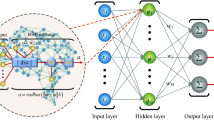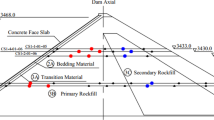Abstract
Parameters identification of rockfill materials is a crucial issue for high rockfill dams. Because of the scale effect, random sampling and sample disturbance, it is difficult to obtain the actual mechanical properties of rockfill from laboratory tests. Parameters inversion based on in situ monitoring data has been proven to be an efficient method for identifying the exact parameters of the rockfill. In this paper, we propose a modified genetic algorithm to solve the high-dimension multimodal and nonlinear optimal parameters inversion problem. A novel crossover operator based on the sum of differences in gene fragments (SoDX) is proposed, inspired by the cloning of superior genes in genetic engineering. The crossover points are selected according to the difference in the gene fragments, defining the adaptive length. The crossover operator increases the speed and accuracy of algorithm convergence by reducing the inbreeding and enhancing the global search capability of the genetic algorithm. This algorithm is compared with two existing crossover operators. The modified genetic algorithm is then used in combination with radial basis function neural networks (RBFNN) to perform the parameters back analysis of a high central earth core rockfill dam. The settlements simulated using the identified parameters show good agreement with the monitoring data, illustrating that the back analysis is reasonable and accurate. The proposed genetic algorithm has considerable superiority for nonlinear multimodal parameter identification problems.
Similar content being viewed by others
References
Wei Z, Xiaolin C, Chuangbing Z, et al. Creep analysis of high concrete- faced rockfill dam. Int J Numer Meth Bio, 2010, 11: 1477–1492
Hua J, Zhou W, Chang X, et al. Study of scale effect on stress and deformation of rockfill. Chin J Rock Mech Eng, 2010, 2: 328–335
Holland J H. Adaptation in natural and artificial system: An introduction with application to biology, control and artificial intelligence. Dissertation of Doctor Degree. Michigan: University of Michigan, 1975
Holland J H. Adaptation in Natural and Artificial Systems: An Introductory Analysis with Applications to Biology, Control, and Artificial Intelligence. Cambridge: MIT Press, 1992
Van Laarhoven P J, Aarts E H. Simulated Annealing. Netherlands: Springer Science & Business Media, 1987
Aarts E, Korst J. Simulated Annealing and Boltzmann Machines: A Stochastic Approach to Combinatorial Optimization and Neural Computing. Chichester: John Wiley and Sons Inc., 1988
Dowsland K A, Thompson J M. Simulated Annealing. Berlin: Springer Berlin Heidelberg, 2012. 1623–1655
Shen H, Zhou J, Peng Q, et al. Multi-objective interplanetary trajectory optimization combining low-thrust propulsion and gravity-assist maneuvers. Sci China Tech Sci, 2012, 55: 841–847
Storn R, Price K. Differential Evolution-A Simple and Efficient Adaptive Scheme for Global Optimization Over Continuous Spaces. Berkeley: ICSI, 1995
Herrera F, Lozano M, Verdegay J L. Fuzzy connectives based crossover operators to model genetic algorithms population diversity. Fuzzy Set Syst, 1997, 1: 21–30
Storn R, Price K. Differential evolution–a simple and efficient heuristic for global optimization over continuous spaces. J Global Optim, 1997, 4: 341–359
Eberhart R C, Kennedy J. A New Optimizer Using Particle Swarm theory. New York: Nagoya, 1995. 39–43
Kennedy J. Particle Swarm Optimization. Boston: Springer, 2010. 760–766
Ma G, Zhou W, Chang X. A novel particle swarm optimization algorithm based on particle migration. Appl Math Comput, 2012, 11: 6620–6626
Zhang S, Ou J. BP-PSO-based intelligent case retrieval method for high-rise structural form selection. Sci China Tech Sci, 2013, 56: 940–944
De Jong K A. An analysis of the behavior of a class of genetic adaptive systems. Dissertation of Doctor Degree. Michigan: University of Michigan, 1975
Goldberg D E, Holland J H. Genetic algorithms and machine learning. Mach Learn, 1988, 2: 95–99
Goldberg D E. Real-coded genetic algorithms, virtual alphabets, and Blocking. Urbana, 1990, 51: 61801
Janikow C Z, Michalewicz Z. An experimental comparison of binary and floating point representations in genetic algorithms. ICGA, 1991. 31–36
Michalewicz Z, Logan T, Swaminathan S. Evolutionary Operators for Continuous Convex Parameter Spaces. River Edge, NJ: World Scientific Publishing, 1994. 84–97
Radcliffe N J. Equivalence class analysis of genetic algorithms. Complex Syst, 1991, 2: 183–205
Ono I, Kita H, Kobayashi S. A real-coded genetic algorithm using the unimodal normal distribution crossover. Advances in evolutionary computing. Springer Berlin Heidelberg, 2003. 213–237
Wright A H. Genetic algorithms for real parameter optimization. Found Genet Algorithm, 1991, 1: 205–218
Tsutsui S, Yamamura M, Higuchi T. Multi-parent recombination with simplex crossover in real coded genetic algorithms. In: Proceedings of the Genetic and Evolutionary Computation Conference, Florida, 1999. 657–664
Deb K, Anand A, Joshi D. A computationally efficient evolutionary algorithm for real-parameter optimization. Evol Comput, 2002, 4: 371–395
Deep K, Thakur M. A new crossover operator for real coded genetic algorithms. Appl Math Comput, 2007, 1: 895–911
Thakur M. A new genetic algorithm for global optimization of multimodal continuous functions. J Comput Sci-Neth, 2014, 2: 298–311
Elsayed S M, Sarker R A, Essam D L. A new genetic algorithm for solving optimization problems. Eng Appl Artif Intel, 2014, 27: 57–69
Chen Q, Liu B, Zhang Q, et al. Problem definition and evaluation criteria for CEC 2015 special session and competition on bound constrained single-objective computationally expensive numerical optimization. https://mysites.ntu.edu.sg
Michalewicz Z. Genetic Algorithms + Data Structures = Evolution Programs. Berlin: Springer Science & Business Media, 2013
Xiao Y, Liu H, Chen Y, et al. Strength and deformation of rockfill material based on large-scale triaxial compression tests. I: Influences of density and pressure. J Geotech Geoenviron, 2014, 12: 4014070
Xiao Y, Liu H, Chen Y, et al. Strength and deformation of rockfill material based on large-scale triaxial compression tests. II: Influence of particle breakage. J Geotech Geoenviron, 2014, 12: 4014071
Xiao Y, Liu H, Chen Y, et al. Bounding surface model for rockfill materials dependent on density and pressure under triaxial stress conditions. J Eng Mech, 2013, 4: 4014002
Xiao Y, Liu H, Chen Y, et al. Bounding surface plasticity model incorporating the state pressure index for rockfill materials. J Eng Mech, 2014, 11: 4014087
Duncan J, Chang C. Nonlinear analysis of stress and strain in soils. J Soil Mech Found, 1970, 5: 1629–1653
Li G, Ni Z, Fu H, et al. Experimental studies on rheological behaviors for rockfills in concrete faced rockfill dam. Chin J Rock Soli Mech, 2004, 11: 1712–1716
Tomlin A S. The use of global uncertainty methods for the evaluation of combustion mechanisms. Reliab Eng Syst Safe, 2006. 10–11: 1219–1231
Author information
Authors and Affiliations
Corresponding author
Rights and permissions
About this article
Cite this article
Zhou, W., Li, S., Ma, G. et al. Parameters inversion of high central core rockfill dams based on a novel genetic algorithm. Sci. China Technol. Sci. 59, 783–794 (2016). https://doi.org/10.1007/s11431-016-6017-2
Received:
Accepted:
Published:
Issue Date:
DOI: https://doi.org/10.1007/s11431-016-6017-2




